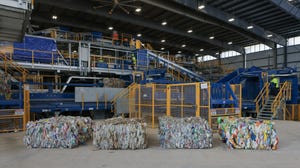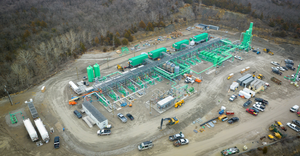Take the Credit and Run
December 1, 2004
Kathleen White
A SEVEN-YEAR EFFORT by the Solid Waste Association of North America (SWANA), Silver Spring, Md., to reinstate tax credits for landfill gas-to-energy (LFGE) projects was realized when President George W. Bush signed H.R. 4520 into law on Oct. 28. Although industry experts view the tax credits as a stopgap measure, they're hopeful the law will be a catalyst to stimulate market development and, eventually, more aggressive credits.
R-E-S-P-E-C-T
The new tax credits are part of a corporate tax measure, entitled the American Jobs Creation Act of 2004, which was approved by Congress on Oct. 14. Contained in section 45 of the Internal Revenue Service (IRS) Tax Code, the credits apply to LFGE and waste-to-energy (WTE) facilities placed in service between Oct. 23, 2004, and Dec. 31, 2005. The credit is good for 5 years at 0.9 cents per kilowatt hour (kWh) and applies to electric projects only.
“The significant issue here is the recognition of landfill gas and, for the first time ever, WTE as renewable energy sources,” says John Skinner, SWANA CEO.
In Section 45 of the new law, LFGE and WTE are included with wind, solar, geothermal and other long-recognized renewable energy sources. Moreover, WTE facilities are recognized in the renewable energy grouping for the first time. The previous LFGE tax credit, which expired in 1998, included LFGE in Section 29 of the IRS Tax Code — apart from wind, solar and other renewable energy sources. However, the Section 29 tax credit for LFGE was twice the amount of the current credit.
“It's less of an incentive than has been offered in the past … but in some ways we're encouraged because it has put LFGE alongside wind and solar energy and other green renewables,” says Chris Voell, program manager of the Environmental Protection Agency (EPA) Landfill Methane Outreach Program (LMOP), Washington, D.C.
“We're happy that there is a landfill gas (LFG) tax credit for electricity projects, but we'd like the amount, length and payout period to be more generous,” says Bill Sells, director of federal relations for the Environmental Industry Associations, (EIA), Washington, D.C. Many of EIA's members, most notably Houston-based Waste Management Inc., joined SWANA in lobbying for the LFGE tax credit.
“The new tax credit is certainly smaller than we were attempting to achieve — that was done for budgetary reasons and to get the bill enacted,” Skinner adds. “We are actively working on extending the size of the tax credit.”
SWANA's Landfill Gas Advocacy Coalition, which had been working to reinstate the LFGE tax credit prior to its expiration in 1998, will be pushing to increase the size of the Section 45 tax credit as well as extend its placed-in-service deadline, Skinner says. Ideally, SWANA would like to make tax credits for LFGE and WTE projects equitable with those for wind, solar and geothermal energy. For instance, wind energy received a tax credit of 1.8 cents per kWh for 10 years, while geothermal and solar energy received the same tax credit for 5 years.
“We're going to work very hard to put all renewables truly in the same boat,” Skinner says. “As long as [LFGE and WTE] are treated like the others, we'll be satisfied.”
Short-Term Effect
Industry officials generally agree that the new credit will not be a boon for LFGE projects because of the short time they have to come online to qualify for the credit. Nevertheless, the industry views the law as having some positive, immediate impact.
“We certainly see it as good news that the tax credits have been made available, but we think it will be an incremental benefit,” says Jeff Adix, vice president of finance for Onyx Waste Services Inc., Milwaukee, Wis. Onyx has been developing LFGE projects for five years. The benefit will be incremental because to take advantage of the credit, Onyx would have to immediately begin developing projects that could be in place a year from now — an unlikely scenario for many of the company's larger projects, Adix explains. Projects that are currently being planned or in advanced planning stages are more likely candidates for the tax credit, he adds.
“We're going to continue to be active in examining the potential for projects at almost all of our applicable and eligible landfills, and the credit is a good supporting step,” Adix says. “Because of the limitations of the tax credit, however, we'll use it to get projects done. It probably won't change our fundamental approach.”
The short duration for the tax credit also limits opportunities for most municipal governments to get projects going, says Dave Traeger, management consultant and vice president of HDR Engineering, Omaha, Neb., a consulting company that helps to develop LFGE and other solid waste projects. “Because [municipal governments] have to go through a public process, it's a pretty short window for them to organize economics and get [projects] in place,” he says.
Despite the short placed-in-service window, the tax credits should provide a needed boost for small-to-medium LFGE projects, as well as those that were marginally feasible or stalled, Traeger says. “A lot of larger landfills have already reacted to the [previous] tax credits. It's now the smaller and mid-size ones that are looking into it.”
According to SWANA's calculations, a 1 megawatt (MW) LFGE project would receive an average tax credit of $67,000 per year or $337,000 over five years, representing approximately 30 percent of a project's capital costs.
Still, as EPA's Voell points out, unlike the wind industry's heavy reliance on tax credits, LFGE projects have learned to survive on their own. “Our industry, in the past couple of years, has brought up 25 new projects a year in the absence of tax credits,” Voell says. “We've been able to fit landfill gas projects in renewable portfolios and green energy programs.”
Escalating natural gas prices brought on by damaged Gulf of Mexico drilling facilities due to this season's plethora of hurricanes and the precarious situation in the Middle East have been fueling the latest LFGE projects. “The industry has been far from standing still,” Voell says. “The addition of the tax credit will enable some more new projects to move forward.”
Only the Beginning
Private industry, partly driven by natural gas prices, also is catching on to the potential environmental and economic benefits of using landfill gas (LFG) as a fuel source. “Because of the tax credit … I would say we're going to see increased interest from businesses in the country,” Voell says.
Prior to implementation of the tax credits, for instance, LMOP saw a marked increase in the number of industries interested in co-locating next to a landfill and tapping into LFG as a clean, reliable energy source, Voell says. At 4 to 6 cents per kWh installed, LFG is one of the most cost-effective renewable energy sources, he adds.
High-profile companies such as S.C. Johnson, General Motors, and Chrysler Automotive have begun using LFG as an energy source at some of their U.S. plants. “As companies of that stature use this fuel, the media attention follows,” Voell says.
The potential for these businesses to further tap into the LFGE market is strong. With 370 LFGE projects already operational in the United States, LMOP has identified more than 600 candidate landfills with 1,450 MW of potential capacity or 275 billion cubic feet per year of LFG for direct use, Voell says.
All of these factors, in addition to the tax credits, should bode well for the industry in the next few years.
In the meantime, SWANA would like the 109th Congress to increase the tax credit to at least 12 cents per kWh and have a minimum three-year placed-in-service window. The association would also like to increase the pay-out schedule from five to 10 years. At the desired 12-cent tax credit, SWANA envisions 175 new projects could go online in three years.
Skinner says his organization is optimistic about achieving the desired legislative changes particularly because the administration that approved H.R. 4520 in the first place will be in office for four more years. “The President supported comprehensive energy legislation … in his energy policy,” Skinner says. “The current administration will likely support it as it did in the past. Therefore, there's an increased likelihood of it passing.”
However, as EIA's Sells points out, President Bush has other issues on his agenda that will likely take precedence and may eat up potential funding for a tax credit expansion. “I don't think President Bush will make this his priority … What it will all come down to will be is there money at the end of the day?”
Others in the industry also are cautiously optimistic about expecting a credit extension soon. “I'd be cautious about how long it will take to expand this in the legislature when it was a fairly lengthy process to get this approved,” Adix says. Moreover, the current credits are embedded in legislation that addresses numerous issues, a factor that held up previous attempts to pass LFGE tax credits. In the past, LFGE tax credits were housed in bills that kept getting sidelined by other issues.
Despite these misgivings, Adix and others remains hopeful that the tax credit will eventually be expanded. “We certainly hope this is another first step for tax credit support for this industry versus the final outcome.”
Kathy White is a contributing editor based in Portland, Ore.
You May Also Like


